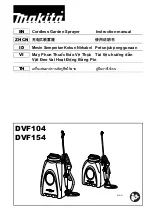
CAPACITOR TESTING:
A capacitor is an electrical component that stores electricity. Capacitors are usually used to help start a motor or make a motor run more efficiently.
The following instructions can be used to test any capacitor.
WARNING!
A CAPACITOR CAN SHOCK YOU EVEN WHEN A MACHINE IS UNPLUGGED. NEVER TOUCH CAPACITOR TERMINALS WITH
YOUR FINGERS. ALWAYS USE TOOLS WITH INSULATED HANDLES. NEVER DISCHARGE A CAPACITOR NEAR FLAMMABLE
LIQUIDS OR VAPORS.
1 Visually inspect the capacitor for leaks, mechanically damage or loose terminals. Replace it if any of these problems exist.
2 Unplug the machine and remove the capacitor(s).
If capacitor(s) are attached to the control board the test can not be perormed.
3 “SEE ABOVE WARNING” Using a screwdriver with
insulated handles, hold so that the blade contacts the
capacitor terminals as shown in Fig. A. This will
“discharge” the capacitor.
4 Put a volt-Ohm meter on the R X 100 scale.
5 While watching the meter, connect the 2 leads to the 2 terminals on the capacitor.
If the capacitor is good, the meter needle will go to the right (toward 0 resistance) (Fig. 1), then to the left (toward - maximum resistance)
If the meter needle goes all the way to the right and stays there, the capacitor is defective.(Fig.2)
If the meter needle stays all the way to the left (doesn't move at all when connected to the capacitor), the capacitor is defective.(Fig. 3)
FIG. A
Capacitor
GOOD
BAD
BAD
8









































